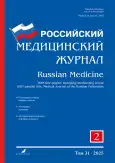Comparative clinical and morphological characteristics of synovial sarcoma in children and adults
- Authors: Bulanov D.V.1
-
Affiliations:
- Pirogov Russian National Research Medical University
- Issue: Vol 31, No 2 (2025)
- Pages: 187-193
- Section: Reviews
- URL: https://bakhtiniada.ru/0869-2106/article/view/313394
- DOI: https://doi.org/10.17816/medjrf642229
- ID: 313394
Cite item
Abstract
This review compares the clinical and morphological characteristics of synovial sarcoma in children and adults (over 18 years of age). Russian medical publications do not provide statistical data on the incidence of synovial sarcoma in different age groups in Russia. However, according to available data, synovial sarcoma accounts for 4% of malignant soft tissue tumors in children and adolescents; the highest incidence is reported in patients aged 15–35 years, with males slightly outnumbering females. In children, synovial sarcoma is the most prevalent type of sarcoma other than rhabdomyosarcoma, accounting for approximately 30% of all sarcomas detected in childhood. Thus, this condition is one of the most significant challenges in pediatric oncology. Synovial sarcoma in children frequently affects the limbs, particularly the areas near joints, making early diagnosis difficult because symptoms can overlap with those of injuries or inflammation. Notably, synovial sarcomas in children and adults have several distinct clinical and pathomorphological characteristics. Tumors in children are frequently more aggressive, which is associated with high cell proliferation and an increased risk of early metastasis. In adults, the disease may develop more slowly, but it is more likely to be detected at later stages due to less severe symptoms. Clinical manifestations of synovial sarcoma include pain, swelling, and limited mobility in the affected area. However, these symptoms may be less severe in children, making timely diagnosis difficult. Pathomorphological characteristics of the tumor include a biphasic structure with both epithelioid and spindle cell components, necessitating a thorough histopathological examination to make an accurate diagnosis. Synovial sarcoma is a significant medical concern in both pediatric and adult oncology. Further research is warranted to clarify epidemiological data and develop effective approaches to early diagnosis and personalized treatment.
Full Text
##article.viewOnOriginalSite##About the authors
Dmitry V. Bulanov
Pirogov Russian National Research Medical University
Author for correspondence.
Email: dbulanov81@gmail.com
ORCID iD: 0009-0005-3772-6643
SPIN-code: 2641-6658
MD, Cand. Sci. (Medicine), Associate Professor
Russian Federation, MoscowReferences
- Bulanov DV, Rogozhin DV. Ewing's sarcoma and undifferentiated round-cell sarcomas of bones and soft tissues: a modern view on the issues of morphological classification and differential diagnosis. Russian News of Clinical Cytology. 2023;27(3):12–18. doi: 10.24412/1562-4943-2023-3-0002 EDN: DJDIXW
- Bulanov DV. Morphological and molecular biological characteristics of synovial sarcoma. Modern aspects. Russian News of Clinical Cytology. 2023;27(4):10–14. doi: 10.24412/1562-4943-2023-4-0002 EDN: VIOHQH
- Sbaraglia M, Bellan E, Dei Tos AP. The 2020 WHO classification of soft tissue tumours: news and perspectives. Pathologica. 2021;113(2):70–84. doi: 10.32074/1591-951X-213 EDN: AJSBLT
- Choi JH, Ro JY. The 2020 WHO classification of tumors of soft tissue: selected changes and new entities. Adv Anat Pathol. 2021;28(1):44–58. doi: 10.1097/PAP.0000000000000284
- Black JO, Al-Ibraheemi A, Arnold MA, et al. The pathologic diagnosis of pediatric soft tissue tumors in the era of molecular medicine: the sarcoma pediatric pathology research interest group perspective. Arch Pathol Lab Med. 2024;148(1):107–116. doi: 10.5858/arpa.2022-0364-RA
- Anderson WJ, Doyle LA. Updates from the 2020 World Health Organization classification of soft tissue and bone tumours. Histopathology. 2021;78(5):644–657. doi: 10.1111/his.14265 EDN: ULXORM
- Cho EB, Lee SK, Kim JY, Kim Y. Synovial sarcoma in the extremity: diversity of imaging features for diagnosis and prognosis. Cancers (Basel). 2023;15(19):4860. doi: 10.3390/cancers15194860 EDN: CRCKST
- Sultan I, Rodriguez-Galindo C, Saab R, et al. Comparing children and adults with synovial sarcoma in the Surveillance, Epidemiology, and End Results program, 1983 to 2005: an analysis of 1268 patients. Cancer. 2009;115(15):3537–3547. doi: 10.1002/cncr.24424
- Amin MB, Edge SB, Greene FL, et al, editors. AJCC cancer staging manual. 8th ed. New York, NY: Springer; 2017.
- Zhu D, Zheng W, Zhu Z, et al. Epidemiology, incidence, and survival of synovial sarcoma of children: a SEER database analysis. Transl Pediatr. 2024;13(7):1179–1189. doi: 10.21037/tp-24-59 EDN: BEWLSM
- Guo Q, Yang Z, Wang K, et al. Whether unplanned excision on synovial sarcoma will influence the prognosis? An retrospective analysis of prognostic factors in 54 synovial sarcoma cases at a single center. Clin Transl Oncol. 2025;27(2):736–744. doi: 10.1007/s12094-024-03643-w
- Giner F, Medina-Ceballos E, López-Reig R, et al. The combined immunohistochemical expression of GLI1 and BCOR in synovial sarcomas for the identification of three risk groups and their prognostic outcomes: a study of 52 patients. Int J Mol Sci. 2024;25(14):7615. doi: 10.3390/ijms25147615 EDN: TYXADC
- Yndestad S, Haugland HK, Goplen D, et al. Germline variants in patients diagnosed with pediatric soft tissue sarcoma. Acta Oncol. 2024;63:586–591. doi: 10.2340/1651-226X.2024.40730 EDN: HCFAHA
- Würtemberger J, Ripperger T, Vokuhl C, et al. Genetic susceptibility in children, adolescents, and young adults diagnosed with soft-tissue sarcomas. Eur J Med Genet. 2023;66(5):104718. doi: 10.1016/j.ejmg.2023.104718 EDN: VENSQM
- Abu-Hijlih R, Sharaf B, Salah S, et al. Germline genetic mutations in adult patients with sarcoma: insight into the middle east genetic landscape. Cancers (Basel). 2024;16(9):1668. doi: 10.3390/cancers16091668 EDN: AGEQNQ
- Nishino S, Kojima N, Sugino H, et al. MUC5AC immunoreactivity in scattered tumor cells is useful for diagnosing CIC-rearranged sarcoma. Virchows Arch. 2024; 485(2):359–363. doi: 10.1007/s00428-024-03863-z EDN: JNWABR
- Singh C, Gharde P, Shah R, et al. Synovial sarcoma in the right thigh of a 25-year-old male: a case report. Cureus. 2024;16(6):e 62526. doi: 10.7759/cureus.62526 EDN: QEHBIB
- Sanchez J, Guevara N, Chapiolkina V, et al. Unveiling rarity: a case report of a poorly differentiated synovial sarcoma mimicking a plunging ranula. Cureus. 2024;16(7):e64290. doi: 10.7759/cureus.64290 EDN: REFFAU
- Ravindran A, Miller MS, Ayers E, et al. A case report of primary pericardial sarcoma. Eur Heart J Case Rep. 2024;8(6):ytae284. doi: 10.1093/ehjcr/ytae284 EDN: PXZMWU
- Bégueret H, Galateau-Salle F, Guillou L, et al. Primary intrathoracic synovial sarcoma: a clinicopathologic study of 40 t(X;18)-positive cases from the French Sarcoma Group and the Mesopath Group. Am J Surg Pathol. 2005;29(3):339–346. doi: 10.1097/01.pas.0000147401.95391.9a
Supplementary files






